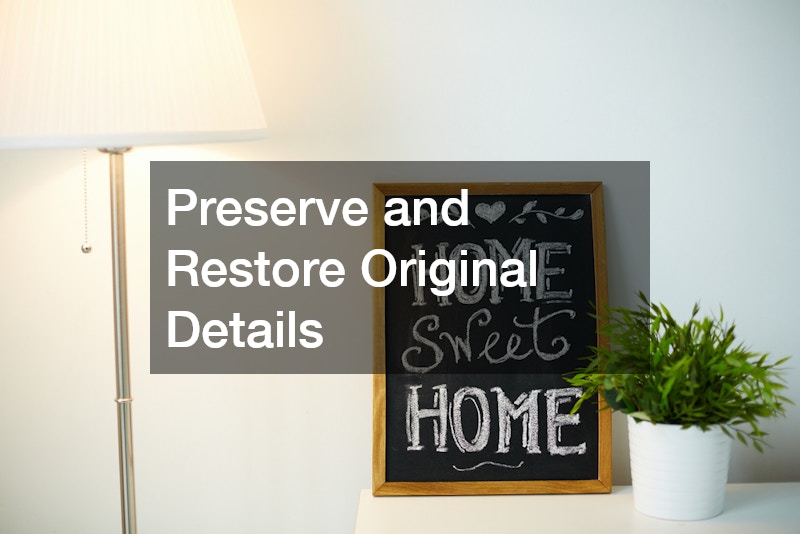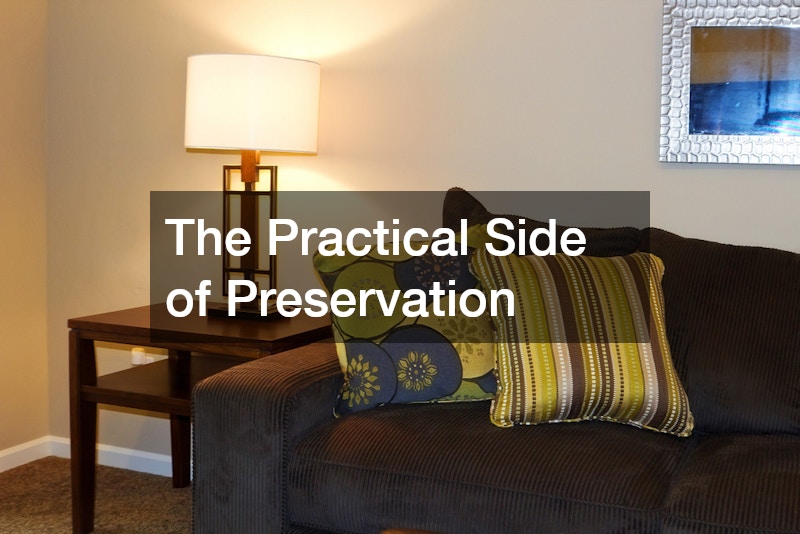There’s something special about an older home — the creak of original hardwood floors, the curve of a handcrafted staircase, or the charm of vintage trim that’s stood the test of time. These small details tell stories of the families who came before and the craftsmanship that’s often missing in newer builds. Yet, as homeowners’ lifestyles evolve, the need to modernize becomes inevitable. The challenge lies in updating comfort and functionality without erasing what makes your home unique.
Renovating while preserving character isn’t just possible — it can result in a space that feels even more authentic. With thoughtful planning, the right professionals, and a keen eye for detail, homeowners can strike that delicate balance between the past and the present.

Assess What Gives Your Home Its Character
Identify Key Architectural Features
Every home has signature features that define its personality. It could be the millwork around your doorways, the vintage glass in your windows, or the ornate plaster ceiling medallions that catch light in the late afternoon. Before knocking down walls or replacing finishes, take the time to catalog what makes your home special.
Many older homes were designed during eras when builders used local materials and hand-finished details, giving each space a one-of-a-kind feel. If you have built-ins, fireplaces, or period hardware, think about ways to keep them. Even refinishing rather than replacing can protect the soul of the space.
When you’re updating exterior features such as roofing, those same principles apply. Consulting with local roofing contractors who understand regional architecture ensures that your new materials match the tone and shape of the home, rather than clashing with it.
Understand the Home’s Era and Style
The next step is understanding what era your home comes from. A mid-century ranch, for example, will have vastly different character than a 1920s bungalow. Researching the architectural style not only helps you make informed renovation choices but also makes your design decisions more intentional.
If your home was built in the early 1900s, it may have been influenced by Craftsman or Colonial styles that emphasized natural materials and symmetry. Preserving those values — through color choices, materials, and layout — helps maintain historical integrity even when adding modern touches.
By respecting the bones of your home, you’re not just keeping its charm intact — you’re honoring the craftsmanship and history that give it life.
Choose a Thoughtful Design Plan
Balance Modern Functionality with Classic Aesthetics
Modern living often demands open layouts, updated electrical systems, and functional kitchens. Yet these upgrades can still coexist beautifully with original character. For example, if you’re opening a wall to connect your dining room and kitchen, replicate period-style trim and molding to tie the spaces together.
Incorporate new cabinetry that nods to your home’s original materials. If your house has natural wood tones, use finishes that complement them instead of competing. Choose lighting fixtures with timeless shapes — perhaps an antique-inspired pendant in a modern finish — to maintain harmony.
The same applies to your home’s exterior. If you’re updating siding, work with local siding contractors who specialize in preserving the look of heritage homes while using modern, energy-efficient materials. They’ll know which textures and colors keep your home’s authentic appeal.
Work with Professionals Who Value Preservation
Not every contractor approaches renovation with preservation in mind, so it’s crucial to find people who share your vision. Seek out architects, designers, and tradespeople who have experience with older homes. They’ll appreciate the nuances that come with plaster walls, original windows, and structural quirks.
Ask to see examples of their previous work and how they’ve balanced modernization with restoration. Clear communication will help you avoid misunderstandings and make sure your renovation feels cohesive from start to finish.

Preserve and Restore Original Details
Repair Instead of Replace When Possible
Preservation often begins with restraint. Rather than tearing out and replacing old materials, look for ways to restore them. Stripping and refinishing original hardwood floors can bring back their warm glow while keeping decades of history alive.
If your plaster walls have cracks, they may not need replacement — a skilled plaster restorer can repair them for a fraction of the cost. The same goes for antique tiles, window frames, and doors. Restoration not only saves money but also retains textures and imperfections that modern materials can’t replicate.
When upgrading floors in newer spaces or additions, consider hardwood floor installations that complement the tone and grain of your existing floors. That consistency helps tie different eras of your home together seamlessly.
Salvage and Repurpose Materials
Another way to maintain authenticity is through material reuse. If you’re removing parts of the home, salvage what you can. Old beams can be turned into fireplace mantels, doors can be transformed into tables, and leftover tiles can become backsplash accents.
Reclaimed materials tell stories of their own. By mixing them into your renovation, you create a connection between the old and the new. Salvage yards and architectural resale shops are full of treasures that fit perfectly into period homes — sometimes even matching your original fixtures exactly.
Not only does this approach preserve character, but it also supports sustainability by reducing waste.
Blend Old and New Elements Seamlessly
Use Complementary Materials and Colors
One of the easiest ways to bridge the gap between eras is through color and material selection. Neutral tones, warm woods, and classic finishes can tie together modern layouts with traditional design.
If your original trim is white, continue that palette throughout the home. When choosing countertops, flooring, or cabinetry, think about how the tones interact. Using similar textures — like matte paint or honed stone — prevents new additions from feeling jarringly modern.
Outside, this philosophy applies too. When upgrading drainage systems, seamless gutters can be installed in a color and finish that blends beautifully with your existing exterior details. They protect your property while maintaining aesthetic integrity.
Incorporate Subtle Modern Touches
The best renovations respect tradition without getting stuck in it. Integrate modern comforts carefully — concealed smart home systems, efficient insulation, and improved lighting can all be incorporated without disrupting visual harmony.
For example, tuck wiring for modern lighting behind crown molding, or choose dimmer switches in finishes that mimic antique brass.
Bathrooms and kitchens can benefit from energy-efficient fixtures with vintage appeal — such as brushed nickel faucets or subway tiles. These subtle updates elevate comfort while complementing your home’s original design.

Add Character Where It’s Missing
Reintroduce Classic Design Details
In some cases, a home may have lost its original charm due to past renovations. Fortunately, you can bring it back. Adding details like wainscoting, chair rails, and crown molding helps restore a sense of craftsmanship.
When installing new fences or exterior additions, working with skilled fence contractors can help you select designs that echo your home’s period style — whether that’s a classic picket fence or wrought-iron detailing. A cohesive exterior enhances curb appeal and reinforces character.
Use Lighting and Décor to Unify the Look
Lighting plays a major role in how character is perceived. A thoughtfully chosen chandelier, wall sconce, or pendant light can bridge old and new elements beautifully.
Mix heirlooms and antiques with contemporary furniture to give rooms depth. For example, a rustic dining table paired with modern chairs can create visual balance. Avoid overdecorating — character thrives when it has space to shine.
Textiles, art, and color accents can all help unify design eras while maintaining the charm that drew you to your home in the first place.
Keep the Home’s Story Alive
Showcase Original Features with Pride
Your home’s imperfections often tell the best stories. Exposed brick, uneven floorboards, or a bit of patina on vintage hardware are reminders of craftsmanship that modern construction rarely replicates.
Rather than hiding these traits, highlight them. Frame a section of original wallpaper behind glass, keep a section of exposed brick visible, or preserve the texture of old plaster walls. These decisions create conversation pieces and make your renovation feel genuine.
Caring for your landscape also supports the home’s story. Work with local paving companies to refresh walkways and driveways using materials that reflect the home’s character — such as brick or stone pavers. Maintaining harmony between the house and its surroundings keeps the property’s charm intact from every angle.
Maintain Character Through Maintenance
Preserving character doesn’t stop once construction wraps up. Regular upkeep keeps your materials and finishes looking their best. Schedule seasonal maintenance for your home’s structure and surrounding landscape.
If your property features mature trees or shrubs that contribute to its historic appeal, partner with tree removal companies that specialize in preservation-focused trimming and health assessments. This approach prevents overgrowth from damaging your home’s exterior while keeping its natural beauty alive.
Routine maintenance also includes keeping outdoor lighting functional, repainting trim, and re-caulking windows as needed. Attention to small details keeps your home looking cared for without eroding its authenticity.

The Practical Side of Preservation
Respecting Modern Safety and Comfort
Maintaining character doesn’t mean sacrificing comfort. Upgrading your plumbing, electrical, and HVAC systems enhances efficiency while making your home safer. Just because these systems are hidden doesn’t mean they can’t support the home’s style.
If your property has an older septic setup, hiring a reliable septic pumping company helps prevent system failures and protects your yard and foundation. Proper maintenance ensures both functionality and longevity, letting you focus on aesthetics without worrying about what’s underground.
Addressing Everyday Comforts
Older homes often have unique quirks — drafts, uneven floors, or pests that find their way into nooks and crannies. Addressing these issues doesn’t detract from character; it protects your investment.
Partnering with reputable pest control services helps safeguard original materials like wood framing and insulation from long-term damage. Routine inspections can prevent infestations that might threaten the integrity of vintage finishes or furniture.
Preservation is just as much about practicality as it is about design. By caring for every system — from electrical to structural — you’re extending the home’s story for decades to come.
Enhancing Curb Appeal While Keeping Character
Respect the Original Layout
When planning exterior renovations, resist the temptation to overhaul everything. The spacing between windows, the slope of your roof, and the width of your porch were all deliberate choices that define your home’s proportions. Maintain these as you make updates.
If you need to add outdoor living spaces or update landscaping, choose materials that complement your home’s façade. For example, if your house features red brick, consider using stone or warm-toned concrete rather than stark white or gray.
Engage local professionals familiar with regional architecture to make sure every addition feels natural rather than forced.
Keep Landscaping in Harmony
Landscaping has a powerful influence on how your home’s character is perceived. Thoughtful planting can soften newer structures, frame architectural details, and connect your home to its environment.
If you’re reworking your yard, consider the long-term care it will need. While tree trimming maintains safety and light, stump grinding services may be necessary after removing dead or diseased trees. This not only improves curb appeal but also prevents regrowth that could damage foundations or pathways.
Low-maintenance shrubs and seasonal blooms can highlight architectural details without distracting from them. The goal is to create balance — a yard that feels like it’s always belonged there.
Blending Character with Modern Living
Integrate New Technology Thoughtfully
Modern technology can enhance character when introduced subtly. Smart thermostats, energy-efficient lighting, and discreet sound systems can all improve comfort without disrupting the home’s style.
Hide wiring behind trim, integrate charging stations into built-ins, or use recessed lighting sparingly to maintain visual warmth. Even small upgrades — like a smart doorbell housed in a vintage-style casing — can merge convenience with timeless design.
The trick is to integrate technology as an enhancement, not a centerpiece. It should work behind the scenes, allowing your home’s true charm to remain center stage.
Celebrate Imperfection
Part of preserving character is embracing imperfection. A slightly uneven floor, a chipped tile, or an aged banister all add texture and authenticity. Trying to make an old home flawless can actually strip it of its personality.
Instead, lean into the craftsmanship. Highlight patinas, restore rather than replace, and let natural wear tell its story. These are the qualities that make your home feel lived in — and loved.
Bringing It All Together
Thoughtful Balance Is Key
Renovating without losing character is about balance — the art of merging what’s timeless with what’s necessary. Every design choice, from the paint color to the materials, contributes to how successfully old and new coexist.
When you preserve original features, repurpose materials, and collaborate with professionals who respect your vision, your renovation will feel cohesive rather than conflicting. It’s not about freezing your home in time — it’s about allowing it to evolve gracefully.
The Long-Term Rewards
Homes that retain their original charm often have greater resale value, but more importantly, they offer emotional rewards that can’t be quantified. There’s a sense of continuity that connects past generations with the present — a living legacy shaped by care and attention.
Whether you’re restoring a Craftsman bungalow, a farmhouse, or a classic suburban colonial, your efforts will pay off in the warmth and authenticity that radiate from every corner.
Preserving your home’s personality doesn’t mean rejecting progress. It means choosing renovations that honor where your home came from while preparing it for the future.
A home renovation doesn’t have to come at the expense of character. When you approach each project with thoughtfulness and respect for history, the results are often more beautiful than before. From choosing materials that complement existing architecture to partnering with professionals who understand preservation, every decision counts.
Embrace the imperfections, restore what’s worth saving, and carefully introduce the new elements that will make your home functional for years to come. With balance and patience, you can modernize your space while keeping its soul intact — creating a home that feels timeless, lived-in, and truly yours.
